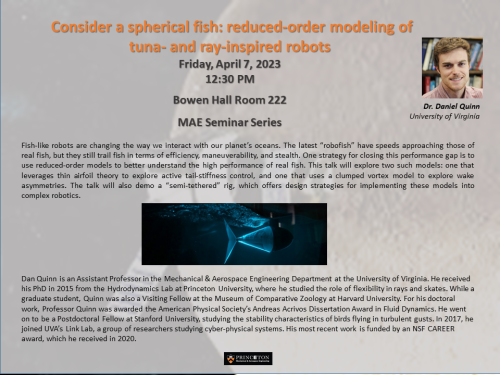Event Date/Time
Location
Bowen Hall
222
222
Series/Event Type
MAE Departmental Seminars
Image

Fish-like robots are changing the way we interact with our planet’s oceans. The latest “robofish” have speeds approaching those of real fish, but they still trail fish in terms of efficiency, maneuverability, and stealth. One strategy for closing this performance gap is to use reduced-order models to better understand the high performance of real fish. This talk will explore two such models: one that leverages thin airfoil theory to explore active tail-stiffness control, and one that uses a clumped vortex model to explore wake asymmetries. The talk will also demo a “semi-tethered” rig, which offers design strategies for implementing these models into complex robotics.
Speaker Bio
Dan Quinn is an Assistant Professor in the Mechanical & Aerospace Engineering Department at the University of Virginia. He received his PhD in 2015 from the Hydrodynamics Lab at Princeton University, where he studied the role of flexibility in rays and skates. While a graduate student, Quinn was also a Visiting Fellow at the Museum of Comparative Zoology at Harvard University. For his doctoral work, Professor Quinn was awarded the American Physical Society’s Andreas Acrivos Dissertation Award in Fluid Dynamics. He went on to be a Postdoctoral Fellow at Stanford University, studying the stability characteristics of birds flying in turbulent gusts. In 2017, he joined UVA’s Link Lab, a group of researchers studying cyber-physical systems. His most recent work is funded by an NSF CAREER award, which he received in 2020.
Image

Dan Quinn
Student
Megan Mazzatenta